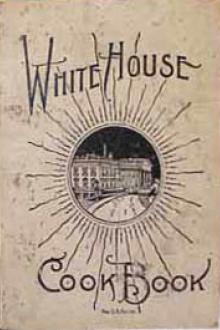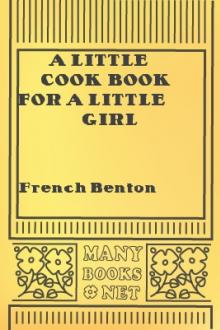The Whitehouse Cookbook (1887), Hugo Ziemann [world of reading .TXT] 📗

- Author: Hugo Ziemann
- Performer: -
Book online «The Whitehouse Cookbook (1887), Hugo Ziemann [world of reading .TXT] 📗». Author Hugo Ziemann
CANNED FRUIT JUICES.
Canned fruit juices are an excellent substitute for brandy or wine in all puddings and sauces, etc.
It is a good plan to can the pure juices of fruit in the summer time, putting it by for this purpose.
Select clean ripe fruit, press out the juice and strain it through a flannel cloth. To each pint of juice add one cupful of white granulated sugar. Put it in a porcelain kettle, bring it to the boiling point, and bottle while hot in small bottles. It must be sealed very tight while it is hot. Will keep a long time, the same as canned fruit.
CANNED TOMATOES.
Canning tomatoes is quite a simple process. A large or small quantity may be done at a time, and they should be put in glass jars in preference to those of tin, which are apt to injure the flavor. Very ripe tomatoes are the best for the purpose. They are first put into a large pan and covered with boiling water. This loosens the skin, which is easily removed, and the tomatoes are then put into the preserving kettle, set over a moderate fire without the addition of water or any seasoning, and brought to a boil. After boiling slowly one-half hour, they are put into the jars while boiling hot and sealed tightly. They will keep two or three years in this way. The jars should be filled to the brim to prevent air from getting in, and set in a cool, dark closet.
TO CAN CORN.
Split the kernels lengthwise with a knife, then scrape with the back of the knife, thus leaving the hulls upon the cob. Fill cans full of cut corn, pressing it in very hard. To press the corn in the can, use the small end of a potato masher, as this will enter the can easily. It will take from ten to a dozen large ears of corn to fill a one-quart can. When the cans are full, screw cover on with thumb and first finger; this will be tight enough, then place a cloth in the bottom of a wash boiler to prevent breakage. On this put a layer of cans in any position you prefer, over the cans put a layer of cloth, then a layer of cans. Fill the boiler in this manner, then cover the cans well with cold water, place the boiler on the fire and boil three hours without ceasing. On steady boiling depends much of your success. After boiling three hours, lift the boiler from the fire, let the water cool, then take the cans from the boiler and tighten, let them remain until cold, then tighten again. Wrap each can in brown paper to exclude the light and keep in a cool, dry cellar and be very sure the rubber rings are not hardened by use. The rings should be renewed every two years. I would advise the beginner to use new rings entirely, for poor rings cause the loss of canned fruit and vegetables in many cases. You will observe that in canning corn the cans are not wrapped in a cloth nor heated; merely filled with the cut corn. The corn in the can will shrink considerable in boiling, but on no account open them after canning.
TO CAN PEAS.
Fill the can full of peas, shake the can so they can be filled well. You cannot press the peas in the can as you did the corn, but by shaking the cans they may be filled quite full. Pour into the cans enough cold water to fill to overflowing, then screw the cover tight as you can with your thumb and first finger and proceed exactly as in canning corn.
String beans are cut as for cooking and canned in the same manner. No seasoning of salt, pepper or sugar should be added.
CANNED PLUMS.
To every pound of plums allow a quarter of a pound of sugar. Put the sugar and plums alternately into the preserving kettle, first pricking the plums to prevent their breaking. Let them stand on the back of the stove for an hour or two, then put them over a moderate fire and allow to come to a boil; skim and pour at once into jars, running a silver spoon handle around the inside of the jar to break the air-bubbles; cover and screw down the tops.
CANNED MINCE MEAT.
Mince meat for pies can be preserved for years if canned the same as fruit while hot, and put into glass jars and sealed perfectly tight, and set in a cool, dark place. One glass quart jar will hold enough to make two ordinary-sized pies, and in this way "mince pies" can be had in the middle of summer as well as in winter, and if the cans are sealed properly, the meat will be just as fine when opened as when first canned.
CANNED BOILED CIDER.
Boiled cider, in our grandmothers' time, was indispensable to the making of a good "mince pie," adding the proper flavor and richness, which cannot be substituted by any other ingredient, and a gill of which being added to a rule of "fruit cake" makes it more moist, keeps longer, and is far superior to fruit cake made without it. Boiled cider is an article rarely found in the market, nowadays, but can be made by any one, with but little trouble and expense, using sweet cider, shortly after it is made, and before fermentation takes place. Place five quarts of sweet cider in a porcelain-lined kettle over the fire, boil it slowly until reduced to one quart, carefully watching it that it does not burn; turn into glass jars while hot and seal tightly, the same as canned fruit. It is then ready to use any time of the year.
CANNED PUMPKIN.
Pumpkins or squash canned are far more convenient for ready use than those dried in the old-fashioned way.
Cut up pumpkin or squash into small pieces, first cutting off the peel; stew them until tender, add no seasoning; then mash them very fine with a potato masher. Have ready your cans, made hot, and then fill them with the hot pumpkin or squash, seal tight; place in a dark, cool closet.
PEACH BUTTER.
Pare ripe peaches and put them in a preserving kettle, with sufficient water to boil them soft; then sift through a colander, removing the stones. To each quart of peaches put one and one-half pounds of sugar, and boil very slowly one hour. Stir often and do not let them burn. Put in stone or glass jars, and keep in a cool place.
PEACHES DRIED WITH SUGAR.
Peel yellow peaches, cut them from the stone in one piece; allow two pounds of sugar to six pounds of fruit; make a syrup of three-quarters of a pound of sugar and a little water; put in the peaches, a few at a time, and let them cook gently until quite clear. Take them up carefully on a dish and set them in the sun to dry. Strew powdered sugar over them on all sides, a little at a time; if any syrup is left, remove to fresh dishes. When they are quite dry, lay them lightly in a jar with a little sugar sifted between the layers.
RED OR PINK COLORING.
Take two cents' worth of cochineal. Lay it on a flat plate and bruise it with the blade of a knife. Put it into half a teacupful of alcohol. Let it stand a quarter of an hour, and then filter it through fine muslin. Always ready for immediate use. Cork the bottle tight.
Strawberry or cranberry juice makes a fine coloring for frosting, sweet puddings and confectionery.
DEEP RED COLORING.
Take twenty grains of cochineal and fifteen grains of cream of tartar finely powdered; add to them a piece of alum the size of a cherry stone and boil them with a gill of soft water in an earthen vessel, slowly, for half an hour. Then strain it through muslin, and keep it tightly corked in a phial. If a little alcohol is added it will keep any length of time.
YELLOW COLORING.
Take a little saffron, put it into an earthen vessel with a very small quantity of cold, soft water, and let it steep till the color of the infusion is a bright yellow. Then strain it, add half alcohol to it. To color fruit yellow, boil the fruit with fresh lemon skins in water to cover them until it is tender; then take it up, spread it on dishes to cool and finish as may be directed.
To color icing, put the grated peel of a lemon or orange in a thin muslin bag, squeezing a little juice through it, then mixing with the sugar.
GREEN COLORING.
Take fresh spinach or beet leaves and pound them in a marble mortar. If you want it for immediate use, take off the green froth as it rises, and mix it with the article you intend to color. If you wish to keep it a few days, take the juice when you have pressed out a teacupful, and adding to it a piece of alum the size of a pea, give it a boil in a saucepan. Or make the juice very strong and add a quart of alcohol. Bottle it air-tight.
SUGAR GRAINS.
These are made by pounding white lump sugar in a mortar and shaking it through sieves of different degrees of coarseness, thus accumulating grains of different sizes. They are used in ornamenting cake.
SUGAR GRAINS, COLORED.
Stir a little coloring—as the essence of spinach, or prepared cochineal, or liquid carmine, or indigo, rouge, saffron, etc.,—into the sugar grains made as above, until each grain is stained, then spread them on a baking-sheet and dry them in a warm place. They are used in ornamenting cake.
CARAMEL OR BURNT SUGAR.
Put one cupful of sugar and two teaspoonfuls of water in a saucepan on the fire; stir constantly until it is quite a dark color, then add a half cupful of water and a pinch of salt; let it boil a few minutes and when cold, bottle.
For coloring soups, sauces or gravies.
TO CLARIFY JELLY.
The white of egg is, perhaps, the best substance that can be employed in clarifying jelly, as well as some other fluids, for the reason that when albumen (and the white of egg is nearly pure albumen) is put into a liquid that is muddy, from substances suspended in it, on boiling coagulates in a flocculent manner, and, entangling with the impurities, rises with them to the surface as a scum, or sinks to the bottom, according to their weight.
CONFECTIONERYIn the making of confections the best granulated or loaf sugar should be used. (Beware of glucose mixed with sugar.) Sugar is boiled more or less, according to the kind of candy to be made, and it is necessary to understand the proper degree of sugar boiling to operate it successfully.
Occasionally sugar made into candies, "creams" or syrups, will need clarifying. The process is as follows: Beat up well the white of an egg with a cupful of cold water and pour it into a very clean iron or thick new tin saucepan, and put into the pan four cupfuls of sugar, mixed with a cupful of warm water. Put on the stove and heat moderately until the scum rises. Remove the pan, and skim off the top, then place on the fire again until the scum rises again. Then remove as before, and so continue until no scum rises.
This recipe is good for brown or yellowish sugar; for





Comments (0)